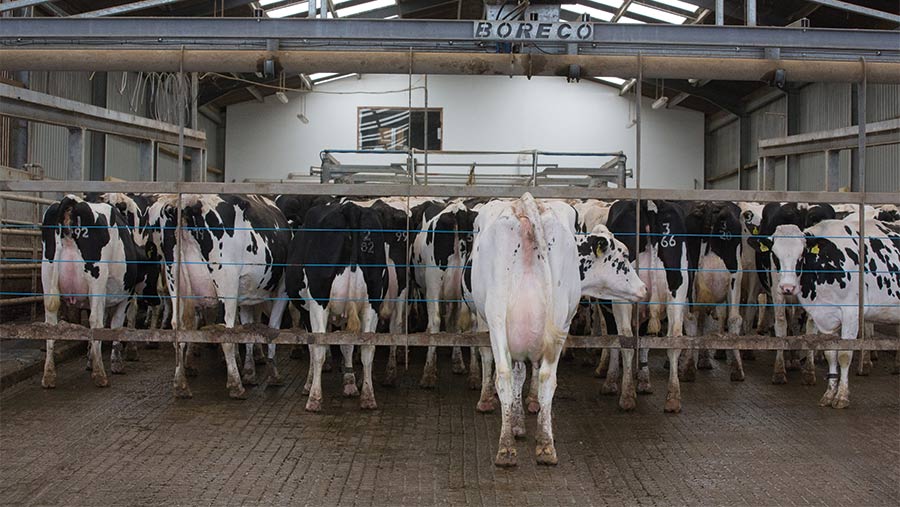Benefits of training heifers to use the parlour
 © Tim Scrivener
© Tim Scrivener A snap poll by Farmers Weekly revealed that 52% of dairy farmers who responded, train their heifers through the parlour and 26% run a separate heifer group.
Both results are surprisingly high, says Andy Dodd of The Farm Consultancy Group.
“Most farms do not have the space to run a separate heifer lactation group. It goes back to labour resource – people run the minimum number of groups to make it easier to manage,” he says.
See also: Why two systems are running separate heifer milking groups
Training heifers pays dividends when heifers learn from older cows. This can be harder to achieve in robot systems based around grazing, says Andy.
On one farm, heifers were not returning from paddocks to be milked.
However, once the farm ran bulling heifers with milking cows, they learned to follow them to the robot and after calving they settled into lactation much more easily.
He thinks running a separate group is a numbers game – small numbers can result in less social interaction in a group.
“A heifer group is better for the animal, but it needs the right infrastructure. The worst thing is to house a heifer group in an inferior shed.
“If you can’t separate heifers, make sure they hit target weight at calving, so they are big enough to compete with cows at the feed face.”
He also says transitioning heifers is important: “People think it isn’t necessary because they won’t give as much milk as a cow, or there is no need to worry about milk fever.
“But this will improve colostrum quality, they will come into milk properly and intakes will be better.”
Spring-block calving herd: Moor Farm, Holywell, Flintshire
Introducing heifers to the parlour in the months leading up to calving is paying dividends for Welsh dairy farmer Rhys Davies, with challenges associated with milking in the 2023 calving season limited to just one animal.
At Moor Farm, Rhys and his parents, Dei and Heulwen, calve their Holstein Friesian pedigree herd over eight weeks from 15 March.
Farm facts
- 81ha farmed
- Ffrwd pedigree herd
- 100 Holstein Friesians plus 80 youngstock
- Average yield 7,500 litres
For in-calf heifers entering the herd at Moor Farm, near Holywell, parlour training begins five months earlier, at housing in October.
This gets the young animals accustomed to the alien environment and noises in the 10/20 herringbone parlour.
A group of 40 or so is run through after the cows have been milked. Rhys says patience is needed for that first session. “The first time takes ages,” he admits.
Gentle approach
Initially, everything from the radio to the compressor are switched off to create a peaceful and calm environment. Those noises are then gradually reintroduced.
“We might turn the radio on, then, at the next session, switch on the parlour and later try shutting the automatic gates so they are standing in a row, and pull the cord for the cake,” he says.
To make the process easier, a couple of older, barren cows are put in with the heifers, to lead the way.
“The biggest problem with heifers is getting that first one through, but if there is a cow among them that knows what to do, the heifers tend to follow,” says Rhys.
Rather than going into the parlour for their first milking, the heifers are milked by a separate milking machine in the calving shed. This allows calves to stay with their dams to ensure they get sufficient colostrum on that first day.
Time invested in parlour training is time well spent, Rhys reckons. “You start off the calving season on the front foot.”
Year-round calving herd: Tyreglwys Farm, Carmarthenshire
Acclimatising heifers to the milking routine starts a week before their due calving date in Geraint Thomas’s dairy herd.
The 180-cow pedigree Holstein and Ayrshire herd at Tyreglwys Farm, near Llanelli, calves over nine months and is run as two groups, with high and low yielders milked separately.
Farm facts
- 129ha farmed
- Gwynnog pedigree herd
- Holstein average yield 9,100 litres
- Ayrshire average yield 8,000 litres
Getting the 65 heifers parlour-ready starts with them joining the low-yielding group.
Here, there is less pressure on them than there would be with the highs, says Geraint, because the lows are getting very little, or no, feed at that point.
“We don’t see any bullying of the heifers because they are not fighting to get in to feed,” he explains.
In the week before calving, each heifer is introduced to the parlour, coming in twice a day with the milking cows.
Encouragement
If the heifers are reluctant or hang back in that initial transition, they are not forced in, but the encouragement continues with each subsequent milking.
It helps that the herd is fed in the parlour, with heifers receiving 4kg initially, rising to 8kg immediately before calving. “When they know that there is food ahead of them, that seems to do the trick,” says Geraint.
He makes no adjustments to the usual routine, keeping noises like the radio on to help with the familiarisation process.
“I am a big fan of having the radio on in the parlour. If anyone else comes into the parlour with a different voice, the cows don’t flinch, as they are already used to hearing lots of different voices on the radio.”
There is no contact with udders until heifers are ready to be milked, but he rarely needs to use a kickbar when the clusters go on. The effort put into training always pays off. “We never get any trouble at all,” he says.
